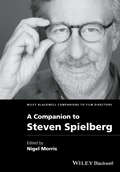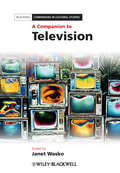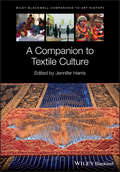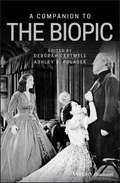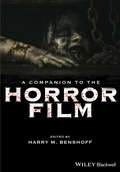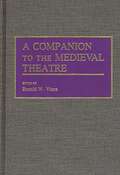- Table View
- List View
A Companion to Steven Spielberg (Wiley Blackwell Companions to Film Directors)
by Nigel MorrisA Companion to Steven Spielberg provides an authoritative collection of essays exploring the achievements and legacy of one of the most influential film directors of the modern era. Offers comprehensive coverage of Spielberg’s directorial output, from early works including Duel, The Sugarland Express, and Jaws, to recent films Explores Spielberg’s contribution to the development of visual effects and computer games, as well as the critical and popular reception of his films Topics include in-depth analyses of Spielberg’s themes, style, and filming techniques; commercial and cultural significance of the Spielberg ‘brand’ and his parallel career as a producer; and collaborative projects with artists and composers Brings together an international team of renowned scholars and emergent voices, balancing multiple perspectives and critical approaches Creates a timely and illuminating resource which acknowledges the ambiguity and complexity of Spielberg’s work, and reflects its increasing importance to film scholarship
A Companion to Steven Spielberg (Wiley Blackwell Companions to Film Directors)
by Nigel MorrisA Companion to Steven Spielberg provides an authoritative collection of essays exploring the achievements and legacy of one of the most influential film directors of the modern era. Offers comprehensive coverage of Spielberg’s directorial output, from early works including Duel, The Sugarland Express, and Jaws, to recent films Explores Spielberg’s contribution to the development of visual effects and computer games, as well as the critical and popular reception of his films Topics include in-depth analyses of Spielberg’s themes, style, and filming techniques; commercial and cultural significance of the Spielberg ‘brand’ and his parallel career as a producer; and collaborative projects with artists and composers Brings together an international team of renowned scholars and emergent voices, balancing multiple perspectives and critical approaches Creates a timely and illuminating resource which acknowledges the ambiguity and complexity of Spielberg’s work, and reflects its increasing importance to film scholarship
A Companion to Television (Blackwell Companions in Cultural Studies #28)
by Janet WaskoA Companion to Television is a magisterial collection of 31 original essays that charter the field of television studies over the past century Explores a diverse range of topics and theories that have led to television’s current incarnation, and predict its likely future Covers technology and aesthetics, television’s relationship to the state, televisual commerce; texts, representation, genre, internationalism, and audience reception and effects Essays are by an international group of first-rate scholars For information, news, and content from Blackwell's reference publishing program please visit www.blackwellpublishing.com/reference/
A Companion to Television (Blackwell Companions to Art History)
by Janet Wasko Eileen MeehanThe latest edition of the acclaimed volume on television studies, featuring new original essays from leading scholars in the field Although the digital age has radically altered the media and communications landscape worldwide, television continues to play a significant part of our lives. From its earliest beginnings through to the present day, television and its influence has been the subject of extensive study, critique, and analysis. A Companion to Television brings together contributions from prominent international scholars comprising a wide range of perspectives on the medium. Original essays define television in its current state, explore why it is still relevant, survey the ways in which television has been studied, discuss how television has changed, and consider what television might look like in the future. Now in its second edition, this compendium includes fresh chapters that cover technological changes affecting television, contemporary approaches to understanding television audiences, new programming trends and developments, and more. Addressing nine key areas of television studies, such as industry, genres, programs, and audiences, the Companion offers readers a balanced, well-rounded, integrative approach to scholarship in the field. This volume: Provides overviews of extensive original research from leading scholars and theorists Examines television’s development and significance in various regions of the world Includes national and regional outlines of television around the world Features theoretical overviews of various critical approaches to television studies Explores historical, economic, institutional, political, and cultural issues studied by media scholars Presenting diverse perspectives on topics ranging from television advertising to satirical representations of the industry, A Companion to Television, Second Edition is an invaluable resource for those in undergraduate courses in television studies, as well as in general media studies and communications.
A Companion to Television (Blackwell Companions to Art History #27)
by Janet Wasko Eileen R. MeehanThe latest edition of the acclaimed volume on television studies, featuring new original essays from leading scholars in the field Although the digital age has radically altered the media and communications landscape worldwide, television continues to play a significant part of our lives. From its earliest beginnings through to the present day, television and its influence has been the subject of extensive study, critique, and analysis. A Companion to Television brings together contributions from prominent international scholars comprising a wide range of perspectives on the medium. Original essays define television in its current state, explore why it is still relevant, survey the ways in which television has been studied, discuss how television has changed, and consider what television might look like in the future. Now in its second edition, this compendium includes fresh chapters that cover technological changes affecting television, contemporary approaches to understanding television audiences, new programming trends and developments, and more. Addressing nine key areas of television studies, such as industry, genres, programs, and audiences, the Companion offers readers a balanced, well-rounded, integrative approach to scholarship in the field. This volume: Provides overviews of extensive original research from leading scholars and theorists Examines television’s development and significance in various regions of the world Includes national and regional outlines of television around the world Features theoretical overviews of various critical approaches to television studies Explores historical, economic, institutional, political, and cultural issues studied by media scholars Presenting diverse perspectives on topics ranging from television advertising to satirical representations of the industry, A Companion to Television, Second Edition is an invaluable resource for those in undergraduate courses in television studies, as well as in general media studies and communications.
A Companion to Textile Culture (Blackwell Companions to Art History)
by Dana ArnoldA lively and innovative collection of new and recent writings on the cultural contexts of textiles The study of textile culture is a dynamic field of scholarship which spans disciplines and crosses traditional academic boundaries. A Companion to Textile Culture is an expertly curated compendium of new scholarship on both the historical and contemporary cultural dimensions of textiles, bringing together the work of an interdisciplinary team of recognized experts in the field. The Companion provides an expansive examination of textiles within the broader area of visual and material culture, and addresses key issues central to the contemporary study of the subject. A wide range of methodological and theoretical approaches to the subject are explored—technological, anthropological, philosophical, and psychoanalytical, amongst others—and developments that have influenced academic writing about textiles over the past decade are discussed in detail. Uniquely, the text embraces archaeological textiles from the first millennium AD as well as contemporary art and performance work that is still ongoing. This authoritative volume: Offers a balanced presentation of writings from academics, artists, and curators Presents writings from disciplines including histories of art and design, world history, anthropology, archaeology, and literary studies Covers an exceptionally broad chronological and geographical range Provides diverse global, transnational, and narrative perspectives Included numerous images throughout the text to illustrate key concepts A Companion to Textile Culture is an essential resource for undergraduate and postgraduate students, instructors, and researchers of textile history, contemporary textiles, art and design, visual and material culture, textile crafts, and museology.
A Companion to Textile Culture (Blackwell Companions to Art History)
by Dana ArnoldA lively and innovative collection of new and recent writings on the cultural contexts of textiles The study of textile culture is a dynamic field of scholarship which spans disciplines and crosses traditional academic boundaries. A Companion to Textile Culture is an expertly curated compendium of new scholarship on both the historical and contemporary cultural dimensions of textiles, bringing together the work of an interdisciplinary team of recognized experts in the field. The Companion provides an expansive examination of textiles within the broader area of visual and material culture, and addresses key issues central to the contemporary study of the subject. A wide range of methodological and theoretical approaches to the subject are explored—technological, anthropological, philosophical, and psychoanalytical, amongst others—and developments that have influenced academic writing about textiles over the past decade are discussed in detail. Uniquely, the text embraces archaeological textiles from the first millennium AD as well as contemporary art and performance work that is still ongoing. This authoritative volume: Offers a balanced presentation of writings from academics, artists, and curators Presents writings from disciplines including histories of art and design, world history, anthropology, archaeology, and literary studies Covers an exceptionally broad chronological and geographical range Provides diverse global, transnational, and narrative perspectives Included numerous images throughout the text to illustrate key concepts A Companion to Textile Culture is an essential resource for undergraduate and postgraduate students, instructors, and researchers of textile history, contemporary textiles, art and design, visual and material culture, textile crafts, and museology.
A Companion to the Action Film (Cncz - Wiley Blackwell Companions To National Cinemas Ser.)
by James KendrickAn authoritative guide to the action-packed film genre With 24 incisive, cutting-edge contributions from esteemed scholars and critics, A Companion to the Action Filmprovides an authoritative and in-depth guide to this internationally popular and wide-ranging genre. As the first major anthology on the action film in more than a decade, the volume offers insights into the genre’s historical development, explores its production techniques and visual poetics, and provides reflections on the numerous social, cultural, and political issues it has and continues to embody. A Companion to the Action Film offers original research and critical analysis that examines the iconic characteristics of the genre, its visual aesthetics, and its narrative traits; considers the impact of major directors and stars on the genre’s evolution; puts the action film in dialogue with various technologies and other forms of media such as graphic novels and television; and maps out new avenues of critical study for the future. This important resource: Offers a definitive guide to the action film Contains insightful contributions from a wide range of international film experts and scholars Reviews the evolution of the genre from the silent era to today’s age of digital blockbusters Offers nuanced commentary and analysis of socio-cultural issues such as race, nationality, and gender in action films Written for scholars, teachers and students in film studies, film theory, film history, genre studies, and popular culture, A Companion to the Action Film is an essential guide to one of international cinema’s most important, popular, and influential genres.
A Companion to the Action Film
by James KendrickAn authoritative guide to the action-packed film genre With 24 incisive, cutting-edge contributions from esteemed scholars and critics, A Companion to the Action Filmprovides an authoritative and in-depth guide to this internationally popular and wide-ranging genre. As the first major anthology on the action film in more than a decade, the volume offers insights into the genre’s historical development, explores its production techniques and visual poetics, and provides reflections on the numerous social, cultural, and political issues it has and continues to embody. A Companion to the Action Film offers original research and critical analysis that examines the iconic characteristics of the genre, its visual aesthetics, and its narrative traits; considers the impact of major directors and stars on the genre’s evolution; puts the action film in dialogue with various technologies and other forms of media such as graphic novels and television; and maps out new avenues of critical study for the future. This important resource: Offers a definitive guide to the action film Contains insightful contributions from a wide range of international film experts and scholars Reviews the evolution of the genre from the silent era to today’s age of digital blockbusters Offers nuanced commentary and analysis of socio-cultural issues such as race, nationality, and gender in action films Written for scholars, teachers and students in film studies, film theory, film history, genre studies, and popular culture, A Companion to the Action Film is an essential guide to one of international cinema’s most important, popular, and influential genres.
A Companion to the Biopic
by Deborah Cartmell Ashley D. PolasekThe most comprehensive reference text of theoretical and historical discourse on the biopic film The biopic, often viewed as the most reviled of all film genres, traces its origins to the early silent era over a century ago. Receiving little critical attention, biopics are regularly dismissed as superficial, formulaic, and disrespectful of history. Film critics, literary scholars and historians tend to believe that biopics should be artistic, yet accurate, true-to-life representations of their subjects. Moviegoing audiences, however, do not seem to hold similar views; biopics continue to be popular, commercially viable films. Even the genre’s most ardent detractors will admit that these films are often very watchable, particularly due to the performance of the lead actor. It is increasingly common for stars of biographical films to garner critical praise and awards, driving a growing interest in scholarship in the genre. A Companion to the Biopic is the first global and authoritative reference on the subject. Offering theoretical, historical, thematic, and performance-based approaches, this unique volume brings together the work of top scholars to discuss the coverage of the lives of authors, politicians, royalty, criminals, and pop stars through the biopic film. Chapters explore evolving attitudes and divergent perspectives on the genre with topics such as the connections between biopics and literary melodramas, the influence financial concerns have on aesthetic, social, or moral principles, the merger of historical narratives with Hollywood biographies, stereotypes and criticisms of the biopic genre, and more. This volume: Provides a systematic, in-depth analysis of the biopic and considers how the choice of historical subject reflects contemporary issues Places emphasis on films that portray race and gender issues Explores the uneven boundaries of the genre by addressing what is and is not a biopic as well as the ways in which films simultaneously embrace and defy historical authenticity Examines the distinction between reality and ‘the real’ in biographical films Offers a chronological survey of biopics from the beginning of the 20th century A Companion to the Biopic is a valuable resource for researchers, scholars, and students of history, film studies, and English literature, as well as those in disciplines that examine interpretations of historical figures
A Companion to the Gangster Film
by George S. Larke‐WalshA companion to the study of the gangster film’s international appeal spanning the Americas, Europe, and Asia A Companion to the Gangster Film presents a comprehensive overview of the newest scholarship on the contemporary gangster film genre as a global phenomenon. While gangster films are one of America’s most popular genres, gangster movies appear in every film industry across the world. With contributions from an international panel of experts, A Companion to the Gangster Film explores the popularity of gangster films across three major continents, the Americas, Europe, and Asia. The authors acknowledge the gangster genre’s popularity and examine the reasons supporting its appeal to twenty-first century audiences across the globe. The book examines common themes across all three continents such as production histories and reception, gender race and sexuality, mafia mythologies, and politics. In addition, the companion clearly shows that no national cinema develops in isolation and that cinema is a truly global popular art form. This important guide to the gangster film genre: Reveals how the gangster film engages in complex and contradictory themes Examines the changing face of the gangster film in America Explores the ideas of gangsterism and migration in the Hispanic USA, Latin America and the Caribbean Discusses the wide variety of gangster types to appear in European cinema Contains a review of a wide-range of gangster films from the Americans, Europe, and Asia Written for academics and students of film, A Companion to the Gangster Film offers a scholarly and authoritative guide exploring the various aspects and international appeal of the gangster film genre.
A Companion to the Gangster Film
by George S. Larke-WalshA companion to the study of the gangster film’s international appeal spanning the Americas, Europe, and Asia A Companion to the Gangster Film presents a comprehensive overview of the newest scholarship on the contemporary gangster film genre as a global phenomenon. While gangster films are one of America’s most popular genres, gangster movies appear in every film industry across the world. With contributions from an international panel of experts, A Companion to the Gangster Film explores the popularity of gangster films across three major continents, the Americas, Europe, and Asia. The authors acknowledge the gangster genre’s popularity and examine the reasons supporting its appeal to twenty-first century audiences across the globe. The book examines common themes across all three continents such as production histories and reception, gender race and sexuality, mafia mythologies, and politics. In addition, the companion clearly shows that no national cinema develops in isolation and that cinema is a truly global popular art form. This important guide to the gangster film genre: Reveals how the gangster film engages in complex and contradictory themes Examines the changing face of the gangster film in America Explores the ideas of gangsterism and migration in the Hispanic USA, Latin America and the Caribbean Discusses the wide variety of gangster types to appear in European cinema Contains a review of a wide-range of gangster films from the Americans, Europe, and Asia Written for academics and students of film, A Companion to the Gangster Film offers a scholarly and authoritative guide exploring the various aspects and international appeal of the gangster film genre.
A Companion to the Historical Film
by Robert A. Rosenstone Constantin ParvulescuBroad in scope, this interdisciplinary collection of original scholarship on historical film features essays that explore the many facets of this expanding field and provide a platform for promising avenues of research. Offers a unique collection of cutting edge research that questions the intention behind and influence of historical film Essays range in scope from inclusive broad-ranging subjects such as political contexts, to focused assessments of individual films and auteurs Prefaced with an introductory survey of the field by its two distinguished editors Features interdisciplinary contributions from scholars in the fields of History, Film Studies, Anthropology, and Cultural and Literary Studies
A Companion to the Historical Film
by Robert A. Rosenstone Constantin ParvulescuBroad in scope, this interdisciplinary collection of original scholarship on historical film features essays that explore the many facets of this expanding field and provide a platform for promising avenues of research. Offers a unique collection of cutting edge research that questions the intention behind and influence of historical film Essays range in scope from inclusive broad-ranging subjects such as political contexts, to focused assessments of individual films and auteurs Prefaced with an introductory survey of the field by its two distinguished editors Features interdisciplinary contributions from scholars in the fields of History, Film Studies, Anthropology, and Cultural and Literary Studies
A Companion to the History of American Broadcasting (Blackwell Companions in Cultural Studies)
by Aniko BodroghkozyPresented in a single volume, this engaging review reflects on the scholarship and the historical development of American broadcasting A Companion to the History of American Broadcasting comprehensively evaluates the vibrant history of American radio and television and reveals broadcasting’s influence on American history in the twentieth and twenty-first centuries. With contributions from leading scholars on the topic, this wide-ranging anthology explores the impact of broadcasting on American culture, politics, and society from an historical perspective as well as the effect on our economic and social structures. The text’s original and accessibly-written essays offer explorations on a wealth of topics including the production of broadcast media, the evolution of various television and radio genres, the development of the broadcast ratings system, the rise of Spanish language broadcasting in the United States, broadcast activism, African Americans and broadcasting, 1950’s television, and much more. This essential resource: Presents a scholarly overview of the history of radio and television broadcasting and its influence on contemporary American history Contains original essays from leading academics in the field Examines the role of radio in the television era Discusses the evolution of regulations in radio and television Offers insight into the cultural influence of radio and television Analyzes canonical texts that helped shape the field Written for students and scholars of media studies and twentieth-century history, A Companion to the History of American Broadcasting is an essential and field-defining guide to the history and historiography of American broadcasting and its many cultural, societal, and political impacts.
A Companion to the History of American Broadcasting (Blackwell Companions in Cultural Studies)
by Aniko BodroghkozyPresented in a single volume, this engaging review reflects on the scholarship and the historical development of American broadcasting A Companion to the History of American Broadcasting comprehensively evaluates the vibrant history of American radio and television and reveals broadcasting’s influence on American history in the twentieth and twenty-first centuries. With contributions from leading scholars on the topic, this wide-ranging anthology explores the impact of broadcasting on American culture, politics, and society from an historical perspective as well as the effect on our economic and social structures. The text’s original and accessibly-written essays offer explorations on a wealth of topics including the production of broadcast media, the evolution of various television and radio genres, the development of the broadcast ratings system, the rise of Spanish language broadcasting in the United States, broadcast activism, African Americans and broadcasting, 1950’s television, and much more. This essential resource: Presents a scholarly overview of the history of radio and television broadcasting and its influence on contemporary American history Contains original essays from leading academics in the field Examines the role of radio in the television era Discusses the evolution of regulations in radio and television Offers insight into the cultural influence of radio and television Analyzes canonical texts that helped shape the field Written for students and scholars of media studies and twentieth-century history, A Companion to the History of American Broadcasting is an essential and field-defining guide to the history and historiography of American broadcasting and its many cultural, societal, and political impacts.
A Companion to the Horror Film
by Harry M. BenshoffThis cutting-edge collection features original essays by eminent scholars on one of cinema's most dynamic and enduringly popular genres, covering everything from the history of horror movies to the latest critical approaches. Contributors include many of the finest academics working in the field, as well as exciting younger scholars Varied and comprehensive coverage, from the history of horror to broader issues of censorship, gender, and sexuality Covers both English-language and non-English horror film traditions Key topics include horror film aesthetics, theoretical approaches, distribution, art house cinema, ethnographic surrealism, and horror's relation to documentary film practice A thorough treatment of this dynamic film genre suited to scholars and enthusiasts alike
A Companion to the Horror Film
by Harry M. BenshoffThis cutting-edge collection features original essays by eminent scholars on one of cinema's most dynamic and enduringly popular genres, covering everything from the history of horror movies to the latest critical approaches. Contributors include many of the finest academics working in the field, as well as exciting younger scholars Varied and comprehensive coverage, from the history of horror to broader issues of censorship, gender, and sexuality Covers both English-language and non-English horror film traditions Key topics include horror film aesthetics, theoretical approaches, distribution, art house cinema, ethnographic surrealism, and horror's relation to documentary film practice A thorough treatment of this dynamic film genre suited to scholars and enthusiasts alike
A Companion to the Medieval Theatre
by Ronald W. VinceVince has provided a useful and, for the most part, usable reference work. His introduction should be required reading for anyone approaching medieval theater. ChoiceScholars increasingly see medieval theatre as a complex and vital performance medium related more closely to political, religious, and social life than to literature as we know it. Reflecting the current interest in performance, A Companion to the Medieval Theatre presents 250 alphabetically arranged entries offering a panoramic view of European and British theatrical productions between the years 900 and 1550. The volume features 30 essays contributed by an international group of specialists and includes many shorter entries as well as systematic cross-referencing, a chronology, a bibliography, and a full complement of indexes.Major entries focus on the theatres of the principal linguistic areas (the British Isles, France, Germany, Iberia, Italy, Scandinavia, the Low Countries, and Eastern Europe), and on dramatic forms and genres such as liturgical drama, Passion and saint plays, morality plays, folk drama, and Humanist drama. Other articles examine costume, acting, pageantry, and music, and explore the theatrical dimension of courtly entertainment, the dance, and the tournament. Short entries supply information on over one hundred playwrights, directors, actors and antiquarians whose contributions to the theatre have been documented. This informative guide brings new depth to our appreciation of the richness and color of medieval public entertainments and the symbolism and pageantry that were a part of daily life in the Middle Ages. Designed to appeal to general reader, this volume is also an attractive choice for libraries serving students and scholars of theatre history, English and European literatures, medieval history, cultural history, drama, and performance.
A Companion to the Medieval Theatre
by Ronald W. VinceVince has provided a useful and, for the most part, usable reference work. His introduction should be required reading for anyone approaching medieval theater. ChoiceScholars increasingly see medieval theatre as a complex and vital performance medium related more closely to political, religious, and social life than to literature as we know it. Reflecting the current interest in performance, A Companion to the Medieval Theatre presents 250 alphabetically arranged entries offering a panoramic view of European and British theatrical productions between the years 900 and 1550. The volume features 30 essays contributed by an international group of specialists and includes many shorter entries as well as systematic cross-referencing, a chronology, a bibliography, and a full complement of indexes.Major entries focus on the theatres of the principal linguistic areas (the British Isles, France, Germany, Iberia, Italy, Scandinavia, the Low Countries, and Eastern Europe), and on dramatic forms and genres such as liturgical drama, Passion and saint plays, morality plays, folk drama, and Humanist drama. Other articles examine costume, acting, pageantry, and music, and explore the theatrical dimension of courtly entertainment, the dance, and the tournament. Short entries supply information on over one hundred playwrights, directors, actors and antiquarians whose contributions to the theatre have been documented. This informative guide brings new depth to our appreciation of the richness and color of medieval public entertainments and the symbolism and pageantry that were a part of daily life in the Middle Ages. Designed to appeal to general reader, this volume is also an attractive choice for libraries serving students and scholars of theatre history, English and European literatures, medieval history, cultural history, drama, and performance.
A Companion to the War Film
by Douglas A. Cunningham John C. NelsonA Companion to the War Film contains 27 original essays that examine all aspects of the genre, from the traditional war film, to the new global nature of conflicts, and the diverse formats that war stories assume in today’s digital culture. Includes new works from experienced and emerging scholars that expand the scope of the genre by applying fresh theoretical approaches and archival resources to the study of the war film Moves beyond the limited confines of “the combat film” to cover home-front films, international and foreign language films, and a range of conflicts and time periods Addresses complex questions of gender, race, forced internment, international terrorism, and war protest in films such as Full Metal Jacket, Good Kill, Grace is Gone, Gran Torino, The Messenger, Snow Falling on Cedars, So Proudly We Hail, Tae Guk Gi: The Brotherhood of War, Tender Comrade, and Zero Dark Thirty Provides a nuanced vision of war film that brings the genre firmly into the 21st Century and points the way for exciting future scholarship
A Companion to the War Film
by Douglas A. Cunningham John C. NelsonA Companion to the War Film contains 27 original essays that examine all aspects of the genre, from the traditional war film, to the new global nature of conflicts, and the diverse formats that war stories assume in today’s digital culture. Includes new works from experienced and emerging scholars that expand the scope of the genre by applying fresh theoretical approaches and archival resources to the study of the war film Moves beyond the limited confines of “the combat film” to cover home-front films, international and foreign language films, and a range of conflicts and time periods Addresses complex questions of gender, race, forced internment, international terrorism, and war protest in films such as Full Metal Jacket, Good Kill, Grace is Gone, Gran Torino, The Messenger, Snow Falling on Cedars, So Proudly We Hail, Tae Guk Gi: The Brotherhood of War, Tender Comrade, and Zero Dark Thirty Provides a nuanced vision of war film that brings the genre firmly into the 21st Century and points the way for exciting future scholarship
A Companion to Werner Herzog (Wiley Blackwell Companions to Film Directors #18)
by Brad PragerA Companion to Werner Herzog showcases over two dozen original scholarly essays examining nearly five decades of filmmaking by one of the most acclaimed and innovative figures in world cinema. First collection in twenty years dedicated to examining Herzog’s expansive career Features essays by international scholars and Herzog specialists Addresses a broad spectrum of the director’s films, from his earliest works such as Signs of Life and Fata Morgana to such recent films as The Bad Lieutenant and Encounters at the End of the World Offers creative, innovative approaches guided by film history, art history, and philosophy Includes a comprehensive filmography that also features a list of the director’s acting appearances and opera productions Explores the director’s engagement with music and the arts, his self-stylization as a global filmmaker, his Bavarian origins, and even his love-hate relationship with the actor Klaus Kinski
A Companion to Werner Herzog (Wiley Blackwell Companions to Film Directors #17)
by Brad PragerA Companion to Werner Herzog showcases over two dozen original scholarly essays examining nearly five decades of filmmaking by one of the most acclaimed and innovative figures in world cinema. First collection in twenty years dedicated to examining Herzog’s expansive career Features essays by international scholars and Herzog specialists Addresses a broad spectrum of the director’s films, from his earliest works such as Signs of Life and Fata Morgana to such recent films as The Bad Lieutenant and Encounters at the End of the World Offers creative, innovative approaches guided by film history, art history, and philosophy Includes a comprehensive filmography that also features a list of the director’s acting appearances and opera productions Explores the director’s engagement with music and the arts, his self-stylization as a global filmmaker, his Bavarian origins, and even his love-hate relationship with the actor Klaus Kinski
A Companion to Wong Kar-wai (Wiley Blackwell Companions to Film Directors #13)
by Martha P. NochimsonWith 25 essays that embrace a wide spectrum of topics and perspectives including intertextuality, transnationality, gender representation, repetition, the use of music, color, and sound, depiction of time and space in human affairs, and Wong’s highly original portrayal of violence, A Companion to Wong Kar-Wai is a singular examination of the prestigious filmmaker known around the world for the innovation, beauty, and passion he brings to filmmaking. Brings together the most cutting edge, in-depth, and interesting scholarship on arguably the greatest living Asian filmmaker, from a multinational group of established and rising film scholars and critics Covers a huge breadth of topics such as the tradition of the jianghu in Wong's films; queering Wong's films not in terms of gender but through the artist's liminality; the phenomenological Wong; Wong's intertextuality; America through Wong's eyes; the optics of intensities, thresholds, and transfers of energy in Wong's cinema; and the diasporic presence of some ladies from Shanghai in Wong's Hong Kong Examines the political, historical, and sociological influence of Wong and his work, and discusses his work from a variety of perspectives including modern, post-modern, postcolonial, and queer theory Includes two appendices which examine Wong’s work in Hong Kong television and commercials
